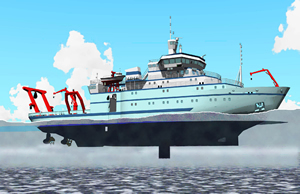UAF awarded first phase of Alaska Region Research Vessel
UAF awarded first phase of Alaska Region Research Vessel
Submitted by Carin Bailey
Phone: (907) 322-8730
08/22/07
After 30 years of planning and development, the University of Alaska Fairbanks has been awarded the first phase of funding for the construction of the Alaska Region Research Vessel, a 236-foot, $123-million ice-capable vessel to support research in high latitudes.
The National Science Foundation announced the $2.5 million award in early August. It will fund the first of four phases of construction of the research vessel. The ARRV will be owned by NSF and operated by UAF on behalf of the entire ocean sciences community, through the University-National Oceanographic Laboratory System. Funding for the remaining phases is contingent upon UAF satisfactorily meeting designated milestones. The estimated completion date for the vessel is 2011.
The new vessel will open up the ice-choked waters of the Alaska region to scientists from all over the world, said Terry Whitledge, director of the Institute of Marine Science at the UAF School of Fisheries and Ocean Sciences and the project leader. "The ARRV will be the first vessel in the U.S. academic research fleet capable of breaking ice up to 2.5 ft thick. With this level of ice-breaking technology, it will literally allow us to go where we haven’t been able to go before."
In addition to its ice-breaking capabilities, the ARRV will allow researchers to collect sediment samples directly from the seafloor, host remotely operated vehicles and use a suite of flexible winches to raise and lower testing equipment throughout the water column. The ship will also be able to transmit real-time information directly to classrooms all over the world. The ARRV will accommodate 26 scientists and students at a time, including those with disabilities.
With its ability to penetrate the polar and sub-polar regions, the ARRV will allow scientists and graduate students to study global issues, such as sea-level rise and climate change and the effects of both on the coastal and arctic ecosystems.
"Scientists today need to be able to take a big-picture look at all factors affecting an ocean ecosystem," said Whitledge. "With its ability to accommodate scientists from different disciplines--such as fisheries, geology, marine biology, meteorology and oceanography--the ARRV will let researchers take an integrated approach to understanding the entire system."
Research in this region is particularly important because of the high productivity of Alaska’s continental shelves and the livelihood of thousands of Alaskans directly connected with the health of Alaska’s fisheries, he said. According to UAF’s proposal, the ship will be headquartered out of the Seward Marine Center. The vessel’s size will require the university to build a new, all-weather dock and additional support facilities at the marine center.
The Alaska Region Research Vessel was designed in 2004 by The Glosten Associates, a group of marine architects located in Seattle. It was developed as a replacement for the R/V Alpha Helix, a 133-foot research vessel that was built in 1966 and officially retired last year.
"This is a huge accomplishment for the entire U.S. oceanographic community," said Whitledge. "The scientific value of this vessel is a large step upward in the new and exciting capabilities that it brings to researchers in the North Pacific, Bering and Beaufort Seas."
Mike Prince, executive secretary for the University-National Oceanographic Laboratory System, an organization of academic institutions that oversee the national academic fleet of research vessels, says that the ARRV is like "a field of dreams."
"The ARRV will provide new opportunities for U.S. scientists and their colleagues worldwide to work in the rich and varied waters of Alaska without having to bring a ship from elsewhere at great expense," said Prince. "The academic research fleet has long been missing a fully capable year-round vessel in Alaska waters, which has made the scheduling of research and educational projects difficult and has limited the ability of scientists to request field work in Alaska."
UAF Chancellor Steve Jones sees the award as an important accomplishment for UAF during the International Polar Year, a major global initiative among scientists to better understand the polar regions of the Arctic and Antarctic.
"An award of this magnitude signals that the National Science Foundation recognizes the extraordinary stature of our university as well as our outstanding School of Fisheries and Ocean Sciences faculty and staff," said Jones. "The ARRV will stand as an IPY legacy for UAF, America’s Arctic University."
CONTACT: Terry Whitledge, UAF Institute of Marine Science director, at (907) 474-7229 or via e-mail at terry@ims.uaf.edu. Carin Bailey, public information officer, at (907) 322-8730 or via e-mail at bailey@sfos.uaf.edu.
ON THE WEB: www.sfos.uaf.edu/arrv
| Overall length | 236 feet |
| Draft | 18 feet |
| Beam | 52 feet |
| Speed, calm open water | 14.2 knots |
| Endurance | 45 days |
| Icebreaking | 2.5 feet at 2 knots |
| Scientist berths | 26 |
| Crew berths | 17-20 |
| Science labs | 2100 square feet |
| Science storage vans 8’x20’ | 2-4 vans |
| Deck working area | 3,690 square feet |
| Freshwater storage | 13,400 gallons |
| Water-making capacity | 6,000 gallons per day |
| Fuel capacity | 179,000 gallons |
| Disability accommodations | Yes, labs, galleys, staterooms |



